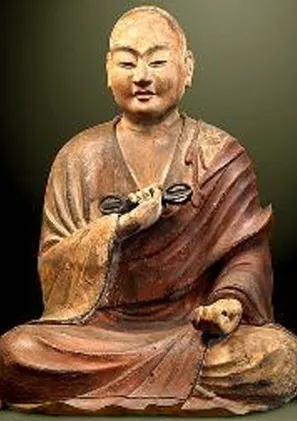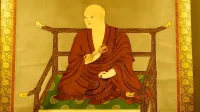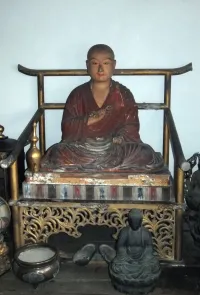Biography
774 - 835
“You can measure the depth of a person's awakening by how they serve others.”
- Kukai
Kūkai (空海) or Kōbō-Daishi was born in what are the present-day Zentsū-ji precincts in the province of Sanuki on the island of Shikoku. At age fifteen, he began to receive instruction in the Chinese Classics and developed a strong interest in Buddhist studies. In 804 Kūkai took part in a government-sponsored expedition to China in order to learn more about the Mahavairocana Sutra, a religious text that he felt would help expand his understanding of Buddhism. Upon his return to Japan Kūkai, a gifted calligrapher, is said to have invented kana, the syllabary in which the Japanese language, in combination with Chinese characters (kanji), is written. According to tradition, he wrote the ‘iroha’, one of the most famous poems in Japanese, which uses every phonetic kana syllable. Using his writings, Kūkai is credited with introducing the esoteric Shingon doctrine of Buddhism to Japan and with synthesizing Buddhist competing teachings into a coherent whole. Kūkai is also said to have brought over from China the teachings of male love. Mount Koya, where his monastery is still located, became a byword for male love up to the end of the pre-modern period. Even though the Vinaya code of monastic discipline for Buddhist monks precluded sexual activity, neither Shintō nor the Japanese interpretation of Confucianism contained any prohibitions. Folklore has it that monks often seem to have felt their vows of chastity did not apply to same-sex relations and thus stories of affairs between monks have become part of tradition. The practice known as shudo was also common among the Samurai Warrior class and continued to be an accepted part of social constructs until Western values began to infiltrate the culture in the late 1800s.
774 - 835
“You can measure the depth of a person's awakening by how they serve others.”
- Kukai
Kūkai (空海) or Kōbō-Daishi was born in what are the present-day Zentsū-ji precincts in the province of Sanuki on the island of Shikoku. At age fifteen, he began to receive instruction in the Chinese Classics and developed a strong interest in Buddhist studies. In 804 Kūkai took part in a government-sponsored expedition to China in order to learn more about the Mahavairocana Sutra, a religious text that he felt would help expand his understanding of Buddhism. Upon his return to Japan Kūkai, a gifted calligrapher, is said to have invented kana, the syllabary in which the Japanese language, in combination with Chinese characters (kanji), is written. According to tradition, he wrote the ‘iroha’, one of the most famous poems in Japanese, which uses every phonetic kana syllable. Using his writings, Kūkai is credited with introducing the esoteric Shingon doctrine of Buddhism to Japan and with synthesizing Buddhist competing teachings into a coherent whole. Kūkai is also said to have brought over from China the teachings of male love. Mount Koya, where his monastery is still located, became a byword for male love up to the end of the pre-modern period. Even though the Vinaya code of monastic discipline for Buddhist monks precluded sexual activity, neither Shintō nor the Japanese interpretation of Confucianism contained any prohibitions. Folklore has it that monks often seem to have felt their vows of chastity did not apply to same-sex relations and thus stories of affairs between monks have become part of tradition. The practice known as shudo was also common among the Samurai Warrior class and continued to be an accepted part of social constructs until Western values began to infiltrate the culture in the late 1800s.
Demography
Demography
Gender Male
Sexual Orientation Gay
Gender Identity Cisgender
Ethnicity Asian/Pacific Rim
Faith Construct Buddhist
Nations Affiliated Japan China
Era/Epoch Middle Ages/ Medieval Period (476-1500)
Field(s) of Contribution
Academics
Art
Mathematics
Poet
Religion
Science
Commemorations & Honors
Aoba Matsuri Festival in Honor of Kūkai
Demography
Gender Male
Sexual Orientation Gay
Gender Identity Cisgender
Ethnicity Asian/Pacific Rim
Faith Construct Buddhist
Nations Affiliated Japan China
Era/Epoch Middle Ages/ Medieval Period (476-1500)
Field(s) of Contribution
Academics
Art
Mathematics
Poet
Religion
Science
Commemorations & Honors
Aoba Matsuri Festival in Honor of Kūkai
Resources
Resources
Abe, Ryuichi. The Weaving of Mantra: Kukai and the Construction of Esoteric Buddhist Discourse. Columbia University Press, 1999.
Czaja, Michael. Gods of Myth and Stone: Phallicism in Japanese Folk Religion. New York and Tokyo: Weatherhill, 1974.
Faure, Bernard. The Red Thread: Buddhist Approaches to Sexuality. Princeton, N. J.: Princeton University Press, 1998.
Guth, Christine. "The Divine Boy in Japanese Art." Monumenta Nipponica 42.1 (1988): 1-23.
Leupp, Gary. Male Colors: The Construction of Homosexuality in Tokugawa Japan. Berkeley: University of California Press, 1995.
McLelland, Mark. Male Homosexuality in Modern Japan: Cultural Myths and Social Realities. Richmond, U. K.: Curzon Press, 2000.
Saikaku, Ihara. The Great Mirror of Male Love. Paul Gordon Schalow, trans. Stanford, Calif.: Stanford University Press, 1990.
Screech, Timon. Sex and the Floating World: Erotic Images in Japan 1700-1820. London: Reaktion Books, 1999.
Watanabe, Tsuneo, and Jun'ichi Iwata. The Love of the Samurai: A Thousand Years of Japanese Homosexuality. London: GMP, 1989.
https://tricycle.org/trikedaily/buddhisms-lgbt-history/
http://www.aisf.or.jp/~jaanus/deta/k/kuukai.htm
Resources
Abe, Ryuichi. The Weaving of Mantra: Kukai and the Construction of Esoteric Buddhist Discourse. Columbia University Press, 1999.
Czaja, Michael. Gods of Myth and Stone: Phallicism in Japanese Folk Religion. New York and Tokyo: Weatherhill, 1974.
Faure, Bernard. The Red Thread: Buddhist Approaches to Sexuality. Princeton, N. J.: Princeton University Press, 1998.
Guth, Christine. "The Divine Boy in Japanese Art." Monumenta Nipponica 42.1 (1988): 1-23.
Leupp, Gary. Male Colors: The Construction of Homosexuality in Tokugawa Japan. Berkeley: University of California Press, 1995.
McLelland, Mark. Male Homosexuality in Modern Japan: Cultural Myths and Social Realities. Richmond, U. K.: Curzon Press, 2000.
Saikaku, Ihara. The Great Mirror of Male Love. Paul Gordon Schalow, trans. Stanford, Calif.: Stanford University Press, 1990.
Screech, Timon. Sex and the Floating World: Erotic Images in Japan 1700-1820. London: Reaktion Books, 1999.
Watanabe, Tsuneo, and Jun'ichi Iwata. The Love of the Samurai: A Thousand Years of Japanese Homosexuality. London: GMP, 1989.
https://tricycle.org/trikedaily/buddhisms-lgbt-history/
http://www.aisf.or.jp/~jaanus/deta/k/kuukai.htm


